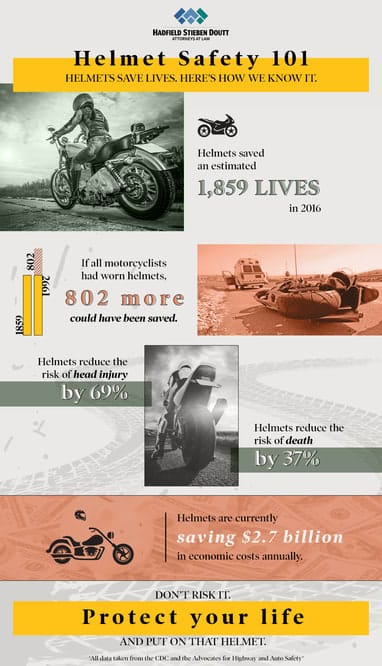In our last couple of blogs, we’ve looked at some important tips and tricks for staying safe during the winter season. From safety resolutions to winter driving tips and avoiding accidents in parking lots. But one thing we haven’t focused on is motorcycle safety. Motorcycle safety is, of course, important all year long, but taking your chopper out on winter roads can pose some especially dangerous situations. With that in mind, we wanted to dedicate today’s blog to cover some of the essentials of motorcycle safety.
Stay tuned for future blog posts that will cover the essentials of a different vehicle that is loved here in Northern Colorado: the bicycle. Once the temperatures start to warm up, the roads will start to fill up with our fellow cyclists of all sorts. So, let’s keep these safety tips in mind. If you have questions about any of this or want to speak to a car accident lawyer, be sure to reach out to the team at Hadfield Stieben & Doutt. You can schedule a free consultation with us today.
Now, let’s dive into some of the essentials of motorcycle safety!
1. Helmets, Helmets, Helmets!
Right now, there are 19 states that have what are known as “universal” helmet laws. This means that everyone, no matter their age, must wear a helmet at all times while riding a motorcycle. This may or may not come as a surprise, but Colorado is not one of these states. We have qualified helmet laws, meaning that certain riders have to wear helmets but not everyone is required to at all times.
For Colorado, riders over the age of 18 are not legally required to wear helmets. However, according to CDOT, if the motorcycle operator or passengers are under age 18, they must wear DOT-approved helmets at all times. This flexibility in helmet laws is for better and worse — though it’s not as laissez-faire as Illinois, Iowa, and New Hampshire, each of which has no helmet requirements whatsoever.
Knowing the local helmet laws is important, of course. But we highly recommend wearing a helmet at all times, no matter the age of the operator or rider. Why? Well, the statistics speak for themselves. You can see how helmets save lives in detail by consulting the infographic below, but in short, riders without helmets are more likely to suffer a fatal head injury or serious brain injury in a motorcycle accident. Helmets save lives.

2. Get the Right Gear
Okay, so you know that it’s important to wear a helmet. The question remains: what kind of helmet? And what other gear will make you safer? Let’s take a look.
As far as helmets are concerned, we mentioned above that it’s not just important to have a DOT-approved helmet, it’s the law (if you’re under the age of 18). DOT-approved helmets are going to be ones that are most likely to prevent injury and death. Helmets typically come in full-face, ¾ coverage, or ½ coverage options. You will have to decide what works best and feels most comfortable for you, but in general, the full-face helmets are going to provide the most protection. Regardless of what style you choose, you want the helmet to fit snugly on your head without being uncomfortably tight or loose enough to twist back and forth without moving your cheeks in the process.
Part of the reason why a full-face helmet is recommended is because it will come with reliable eye protection. While helmets might not be legally required in Colorado, eye protection is. According to CDOT, some form of eye protection is legally required for all riders-drivers and passengers. The best eye protection comes from a visor on a helmet, but goggles or eyeglasses with lenses made from safety glass or plastic are also acceptable. Just keep in mind that a windshield is not considered adequate eye protection.
Another important piece of gear to consider is your motorcycle jacket. A motorcycle jacket can actually have a huge impact on the safety of your ride. It can help with wind resistance while also keeping you warm. A jacket can have an effect on how visible you are to other drivers, which is why it’s recommended to get ones with brighter or reflective designs. On top of that, a quality motorcycle jacket will have built-in protection, including kevlar or carbon fiber areas around the shoulders, elbows, forearms, back, and spine. These armored areas can go a long way toward a safer ride. Just like your helmet, be sure to pick a jacket that has an appropriate fit — snug, but not too tight or loose. Lastly, consider gear such as gloves, boots, and pants, each of which can be tailored to your motorcycle driving experience and help maximize your safety.
3. Know Your Bike
You might already own a motorcycle and have grown to be quite familiar and comfortable with its capabilities. For those who are considering purchasing a motorcycle, however, it is absolutely essential that you choose a bike that is fit for your needs and skill level. There are a lot of motorcycles on the market, and they vary widely in power and manageability. The last thing you want is to find yourself with a motorcycle that feels difficult to ride. You want to match your ride with your riding ability.
Once you’ve identified the type of motorcycle fit for your lifestyle, you’ll want to size yourself and find a motorcycle for your height and size. Your height and body size will determine the safest motorcycle option for you as a new rider getting accustomed to being on a motor with two wheels. When seated, you should easily be able to rest both feet flat on the ground without having to be on tiptoes. Handlebars and controls should be within easy reach. Choose a model that’s easy for you to get on and off the center stand; if it feels too heavy, it probably is. With your approximate size established, the choices narrow down quickly. Within each type available, some will be a better option for a new rider.
4. Hone Your Skills
This might be somewhat straightforward, but its importance can’t be underplayed: it is absolutely vital that you get in a good deal of practice riding your motorcycle in safe conditions. There’s simply no better way to ride safely than through consistent learning and practice. You can do this in a variety of ways. You can learn from a personal mentor/teacher, get practice in parking lots and dedicated tracks, and, perhaps one of the best ways, take classes and get licensing. In Colorado, you will need to get “motorcycle endorsement” added to your valid Colorado driver license. According to the Colorado DMV, this endorsement can be obtained in one of two ways. The first option involves:
- Passing the motorcycle written exam
- Purchasing a motorcycle instruction permit
- Scheduling and pass a motorcycle drive skills test
- And purchasing a new driver license to add motorcycle endorsement at a driver license office
The other option involves:
- Completing a Motorcycle Operator Safety Training (MOST) course
- And presenting your original MOST license waiver card in a driver license office and purchase a new driver license to the add motorcycle endorsement
Whichever route you take, it’s essential that you are practiced and ready to ride before you hit the road.
5. Watch the Weather
This wouldn’t be a winter driving blog without mentioning the hazards that come along with bad Colorado weather. As car accident lawyers, we have seen far too many crashes that have resulted from bad weather, as well as people failing to take the proper precautions in these dangerous conditions.
As we mentioned in our previous blog about winter driving, snowy and icy conditions can have a huge effect on your turning and braking abilities. You need to give plenty of space between vehicles — a significant amount more than you would in normal conditions — in order to safely come to a stop. Be especially gentle with the brakes, throttle, and steering to avoid sliding. On top of that, when riding in strong side winds, be proactive in anticipating the potential push from the side by moving to the side of the lane the wind is coming from. This will give you some leeway in the lane, should a gust nudge you.
That’s just the beginning, of course. Be sure to read our past blogs on winter driving for more information. Gain practice and take your time learning about Colorado-specific conditions. In general, it’s best to avoid driving your motorcycle in anything but clear weather. This isn’t always possible, but keep your eye on the weather reports so you don’t find yourself in needlessly dangerous situations.
Contact Your Trusted Car Accident Lawyer
These are important tips to keep in mind. But accidents can still happen, despite all of our planning and precautions. If an accident does occur, know that HSD Law is your trusted car accident lawyer in Fort Collins. We proudly serve areas throughout Northern Colorado. To ensure that you get what you deserve (and to prevent you from any financial burdens you don’t deserve), be sure to contact HSD Law. We are here to help make the stress of an auto accident a bit more manageable. You can schedule your free consultation today. And be sure to stay tuned for future blog posts about staying safe on the roads!
